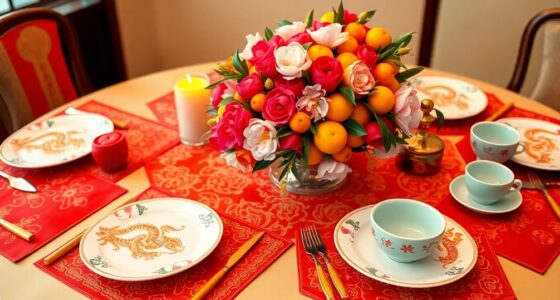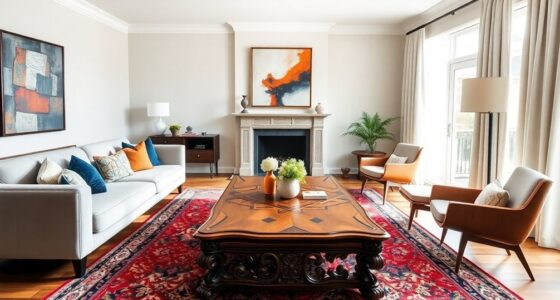The 1960s showcased a vibrant explosion of decor styles that transformed interiors forever. You'd see bold colors like avocado green and burnt orange dominating spaces, reflecting the era's dynamic spirit. Mid-Century Modern furniture with sleek lines emphasized functionality and simplicity, while Space Age designs brought in playful, futuristic elements. Iconic pieces like the Eames Lounge Chair and shag rugs added texture and comfort. Geometric patterns and psychedelic motifs enhanced the visual drama, creating eye-catching environments. If you're curious about how these elements blend to shape modern design trends, there's so much more to explore.
Key Takeaways
- The 1960s embraced bold colors like avocado green, electric blue, and vivid yellow, creating energetic and vibrant interiors.
- Iconic furniture pieces like the Eames Lounge Chair and Panton Chair combined innovative design with functionality, defining the era's aesthetic.
- Psychedelic patterns and playful geometric motifs reflected the counterculture movement, adding visual drama to decor.
- Natural materials and clean lines characterized Mid-Century Modern design, fostering a warm and inviting atmosphere in homes.
- The Space Age inspired futuristic designs with sleek lines, innovative materials, and atomic motifs, symbolizing the optimism of the decade.
Overview of 1960s Design

The 1960s design era was a vibrant mix of innovation and rebellion, shaped by cultural shifts and technological advances.
You'll notice design trends leaning towards bold, vibrant colors, with avocado green making its mark in home decor. The counterculture movement infused psychedelic patterns, contrasting sharply with the minimalism that started to emerge.
This decade celebrated clean lines and functionality, often incorporating natural materials to create a balance between modernity and organic forms.
Modern farmhouse aesthetics began to blend with the futuristic vibes of plastic furniture, exemplified by iconic pieces like Eero Aarnios' Ball Chair.
Don't forget the shag rugs, which added texture and warmth, completing the eclectic look of the 1960s.
This decade truly redefined how you think about home design.
Mid-Century Modern Aesthetics

While many design movements have come and gone, Mid-Century Modern aesthetics continue to captivate homeowners and designers alike with their timeless appeal.
Emerging in the 1950s, this style emphasizes simplicity and functionality, showcasing organic shapes and clean lines. Iconic pieces like the Eames Lounge Chair and George Nelson's Marshmallow Sofa highlight innovative design and comfort, making them staples in modern interiors.
The vibrant color palette, featuring shades like avocado green and burnt orange, reflects the optimism of the post-war era.
Today, Mid-Century Modern influences remain prominent in contemporary design, with its enduring legacy evident in both furniture and decor.
You'll find that the charm of this aesthetic brings a warm, inviting atmosphere to any space.
Space Age Influences

Mid-Century Modern aesthetics laid the groundwork for a new wave of design that emerged during the 1960s, driven by the excitement of the Space Age.
The Space Race fueled a fascination with futuristic design, showcasing sleek lines and bold, bright colors that brought a sense of vibrancy to your home.
Innovative materials, especially plastic, played a vital role, making iconic furniture like the Ball Chair by Eero Aarnio and the Panton Chair by Verner Panton more accessible and versatile.
This era embraced modernity, incorporating star motifs and atomic patterns into everyday objects.
The playful spirit of the time encouraged experimentation, allowing you to create a decor that truly reflected the optimism and exploration of the Space Age.
Color Trends of the Era

During the 1960s, vibrant colors took center stage in interior design, reflecting the era's dynamic spirit. This trend paved the way for young people to explore bold color palettes that continue to influence styles today, including the popular Millennial Pink.
Here are three key aspects of color trends from that time:
- Bright Hues: Colors like electric blue, bold orange, and vivid yellow dominated living rooms, creating energetic spaces.
- Contrasting Combinations: The mix of unexpected colors added excitement and depth to interior designs.
- Playful Patterns: Geometric patterns and psychedelic motifs amplified the visual drama, making spaces feel alive.
As you consider your own interior design, remember how the vibrancy of the past decade can inspire your farmhouse style and more. Additionally, using music therapy can enhance emotional expression and creativity, much like the colors of the 1960s did in design.
Iconic Furniture and Accessories

The 1960s were a transformative period for furniture and accessories, introducing pieces that combined innovative design with everyday functionality.
You couldn't miss the iconic Eames Lounge Chair, a hallmark of Mid-Century Modern style that balanced luxury and comfort. George Nelson's Ball Clock added a playful touch to your home, embodying the whimsical spirit of the Atomic Age.
The Panton Chair showcased fluid design, being the first all-plastic chair and revolutionizing furniture aesthetics. Plus, shag rugs became a defining accessory, bringing bold patterns into your living space.
Although Memphis Design emerged in the 1980s, its influence on the era's furniture, like the Carlton Bookcase, paved the way for a vibrant, geometric approach to home decor that you still appreciate today. Additionally, incorporating unique pieces like an Indonesian decor mask can enhance your space with cultural significance while celebrating artistry from around the world.
Frequently Asked Questions
What Is 80S Decor Style Called?
The 80s decor style is commonly known as Postmodernism.
You'll notice its vibrant colors, bold geometric shapes, and playful irony that break away from minimalist designs. This era embraced the Memphis Design movement, showcasing lively palettes and unconventional forms.
Pastel hues dominated spaces, often mixed with maximalist elements. You might also spot patterned wallpapers and oversized floral prints, all contributing to a distinctive and memorable aesthetic that defined interior design during that decade.
What Was 70S Decor Called?
Imagine stepping into a vibrant kaleidoscope of colors and textures; that's the essence of 70s decor, often dubbed "Groovy Style."
You'll find earthy tones and bold patterns that reflect an ecological awakening, embracing natural materials like wicker and rattan.
The decade's emphasis on self-expression shines through retro shag rugs and eclectic furnishings.
It's a celebration of individuality, where every corner tells a story of freedom and creativity, making your space uniquely you.
What Were the Trends in the 20TH Century Interior Design?
In the 20th century, you'll see a fascinating evolution in interior design trends.
The 1920s introduced Art Deco with its luxurious materials and bold patterns.
The 1930s shifted to Streamline Moderne, emphasizing practicality.
After WWII, Post-War Modernism emerged, favoring organic forms.
The 1950s embraced Atomic Age vibes with bright colors, while the 1960s celebrated Mid-Century Modern styles, inspired by the Space Race.
Each decade brought unique influences that shaped interior aesthetics dramatically.
What Is the 1950S Decorating Style Called?
The 1950s decorating style is called Mid-Century Modern.
You'll notice its clean lines and organic forms, emphasizing simplicity and functionality in furniture and interiors. This style emerged from post-war prosperity, reflecting optimism through vibrant colors and bold patterns.
Iconic pieces, like the Eames Lounge Chair, showcase innovative materials.
If you appreciate minimalism and the integration of indoor and outdoor spaces, this design remains highly relevant and influential in contemporary decor today.
Conclusion
As you explore 1960s decor, you might wonder if the bold styles and vibrant colors were a reaction to the tumultuous events of the decade. Many believe they were! The era's social change sparked creativity, leading to innovative designs that still resonate today. So, when you incorporate these iconic styles into your space, you're not just decorating—you're connecting with a revolutionary spirit. Embrace the energy of the '60s and let it inspire your own design journey!









